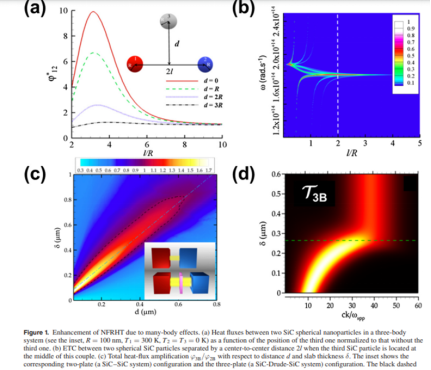On March 4, 2021, Reports on Progress in Physics, a top journal in physics (impact factor: 18.126), published an article entitled Many-body near-field radiative heat transfer: methods, functionalities and applications (see Figure 1) online as composed by the team led by Prof. Cheng Qiang from the State Key Laboratory of Coal Combustion (SKLCC) of the School of Energy and Power Engineering (EPE), Huazhong University of Science and Technology (HUST). Song Jinlin, a postdoctoral fellow in the SKLCC (now having got employed at Wuhan Institute of Technology), is the first author, Zhang Bo, a postgraduate student in the SKLCC, Lu Lu, a PhD student, Prof. Luo Zixue, and Prof. Zhou Xinping from the HUST School of Mechanical Science & Engineering are the co-authors of the paper, and Prof. Cheng Qiang and Associate Prof. Hu Run are the corresponding authors.

Since the prediction that the near-field effect of thermal radiation can be far greater than blackbody radiation at the beginning of this century has been confirmed, theoretical and experimental researches on near-field radiation transmission have flourished and are still in the ascendant. In the past ten years, scholars have gradually shifted to multi-body systems. Compared with two-body systems, multi-body systems are more common. The aggregation effect among multiple objects is more favorable to near-field radiation transmission and also richer in physical connotation.
This review article systematically reviews the development history of near-field radiation transmission in multi-body systems over the past dozens of yearsand looks into the future research directions and application prospects. First of all, it introduces the basic physical principles of near-field radiation transmissionand expounds various theoretical methods for dealing with multi-body near-field radiation transmission, including fluctuation dissipation theory-based analytical method, scattering matrix method, and thermal discrete dipole approximation (DDA) method, wave surface current method, finite difference time domain (FDTD) method, as well as dynamic method combined with Boltzmann equation. Then, it focuses on the new functions in the multi-body near-field radiation transmission system, including enhanced radiation transmission, magneto-optical effect-induced abnormal heat transmission, super-diffusion and ballistic transport behavior, photon traction effect, and aggregated heat emission. Furthermore, the potential applications based on multi-body near-field radiation transmission are discussed, including radiant heat waveguides, heat engines, heat pumps, thermal switches and shunts, non-reciprocal thermal diodes, thermal transistors, and thermal storage and logic gates. Finally, it points out that challenges and opportunities are co-existing in the theoretical experiment research and practical application of multi-body near-field radiation transmission.
In recent years, Prof. Cheng Qiang’s team has published an array of articles focusing on the micro- and nano-scale radiation characteristics and modulation to near-field radiant heat conductivity on top-level and core journals in physics and optics, such as Reports on Progress in Physics, Physical Review Applied, Physical Review B, Applied Physics Letters, Optics Letters, Optics Express, etc. These works will help to further understand the novel heat conductivity mechanism and physical connotation of micro- and nano-scale thermal radiation in the process of energy utilization, and develop new-type thermal radiation-based energy utilization and thermal management technologies. Due to his work related to thermal radiation, Prof. Cheng Qiang has been recommended to serve as a member of the Science Council of the International Center for Heat and Mass Transfer (ICHMT).
This article was co-funded by the National Natural Science Foundation of China, the China Postdoctoral Science Fund, and the Fundamental Research Funds for the Central Universities (HUST).
Paper Link: https://iopscience.iop.org/article/10.1088/1361-6633/abe52b




